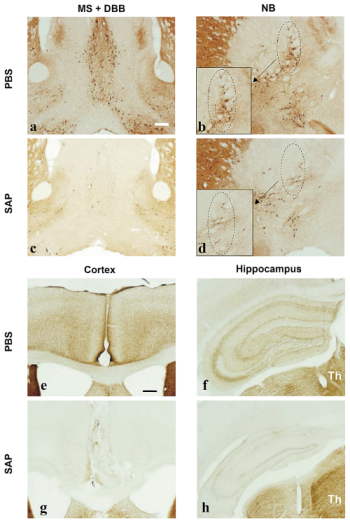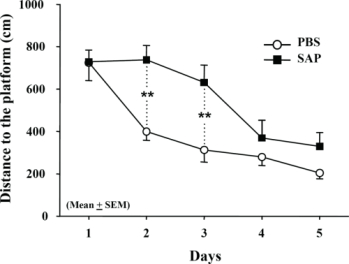Contributed by Pierre-Henri Moreau, Brigitte Cosquer, Hélène Jeltsch, Jean-Christophe Cassel, Chantal Mathis
Laboratoire d’Imagerie et de Neurosciences Cognitives, UMR7191 CNRS,
Equipe de Neurobiologie Cognitive et Comportementale, Université Louis Pasteur,
IFR 37 de Neurosciences, GDR 2905 CNRS, 12 rue Goethe, 67000 Strasbourg, France
The basal forebrain cholinergic neurons (BFCNs) are dramatically affected in several neurodegenerative diseases such as Alzheimer’s disease or Rett syndrome. The characterization of the behavioral consequences of selective BFCN lesions is necessary to study the implication of these neurons in cognitive functions. Until recently, this model was not available in mice, despite the growing interest in this species, due to the creation of a wide variety of genetically modified mouse lines modeling neurodegenerative diseases. The first version of a new cholinergic immunotoxin, mu p75-SAP (Cat. #IT-16), induced specific lesions of the BFCNs associated with dramatic memory performance deficits, but it also showed side effects and poor survival rates [1, 2]. Therefore, as soon as the improved version of mu p75-saporin was released by ATS, we characterized the neuroanatomical and behavioral effects of this new cholinergic neurotoxin.
Mu p75-saporin was administered bilaterally in the cerebral ventricles of male C57BL/6J at the dose of 0.4 µg/mouse. At this dose, all treated mice survived and none of them showed abnormal loss of weight or epileptic-like episodes as obtained with higher doses or reported with the previous version of the toxin. The loss of choline acetyltransferase-immunoreactive neurons was more pronounced in the medial septum (-82%, see figure 1) and the diagonal band of Broca than in the nucleus basalis (-55%). The cholinergic specificity of the lesion was suggested by preserved parvalbumin immunostaining. The hippocampus and several regions of the cortical mantle exhibited a marked drop in the levels of acetylcholinesterase-positive staining. This suggests that septo-hippocampal and basal-cortical projections of the BFCNs underwent massive degeneration. As opposed to the cholinergic toxin 192 IgG-SAP used in rats (Cat. #IT-01), mouse Purkinje cells remained undamaged by mu p75-saporin as suggested by preserved anti-calbindin immunostaining in the cerebellum [3]. The lesion of the BFCNs affected both locomotor activity as well as learning and memory performances. Nocturnal, and to a lesser extent, diurnal locomotor activity was increased in lesioned mice. The rate of acquisition of a water-maze reference memory task was significantly slower in mice treated with mu p75-saporin (see figure 2). Acquisition performance was also affected in the Barnes maze as suggested by an increase in the total number of holes and in the latency to find the target hole. Retention performance of lesioned mice was lower than those of control mice in both spatial memory tasks, although the effect was significant only in the Barnes-maze probe trial. Motivation, visual capacities and sensorimotor coordination appeared unaffected in the water-maze visual discrimination task and the beam-walking test, respectively.
The lesion of BFCNs with mu p75-saporin induces behavioral deficits similar to those reported after ICV 192 IgG-SAP in rats, but without Purkinje cell damage. In addition, this new version of the mouse immunotoxin has fewer side effects and appears more efficient than its predecessor. This safer and more powerful tool may be particularly adapted to improve transgenic models of AD in which amyloid and/or tangle pathologies are expressed, but do not result in extensive loss of cholinergic neurons.


* p < 0.01, significantly different from PBS.
References: (back to top)
- Berger-Sweeney J, Stearns NA, Murg SL, Floerke-Nashner LR, Lappi DA, Baxter MG. 2001. Selective immunolesions of cholinergic neurons in mice: Effects on neuroanatomy, neurochemistry, and behavior. J Neurosci 20:8164-8173.
- Hunter CL, Quintero EM, Gilstrap L, Bhat NR, Granholm AC. 2004. Minocycline protects basal forebrain cholinergic neurons from mu p75-saporin immunotoxic lesioning. Eur J Neurosci 12:3305-3316.
- Traissard N, Herbeaux K, Cosquer B, Jeltsch H, Ferry B, Galani R, Pernon A, Majchrzak M, Cassel JC. 2007. Combined damage to entorhinal cortex and cholinergic basal forebrain neurons, two early neurodegenerative features accompanying Alzheimer’s disease: effects on locomotor activity and memory functions in rats. Neuropsychopharmacol 4:851-871.
